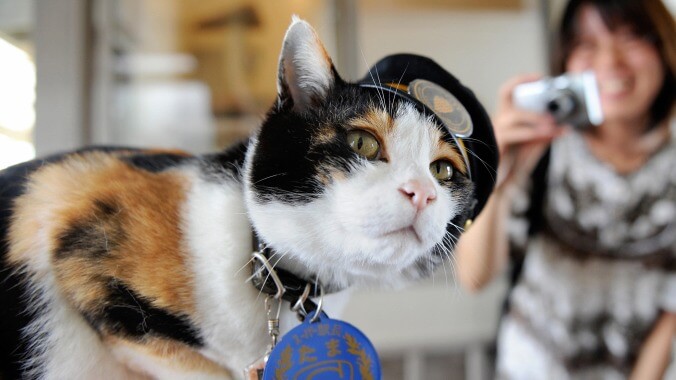This feline station master always kept things meowving right along

This week’s entry: Tama (cat)
What it’s about: A Japanese calico cat who inadvertently saved a railway station in Wakayama Prefecture from closing, becoming both a local celebrity and the station master in the process.
Biggest controversy: Cats are taking jobs away from hardworking humans! In 2004, the financially struggling Wakayama Electric Railway was planning on closing Kishi Station. In 2006 the company destaffed every station along its line to cut costs and named an unofficial station manager from a local business. Kishi Station was nominally overseen by Toshiko Koyama, who had just taken in Tama from a group of strays. Tama quickly became a favorite with commuters, to the point where ridership noticeably increased.
In 2007, the railway gave Tama the title of station master and a year’s worth of cat food by way of a salary. They even made a cat-sized station master’s hat. Ridership continued to increase—by March 2007, traffic at Kishi Station was up 10% over the previous year—and it’s estimated that Tama boosted the local economy by 1.1 billion yen during her tenure as station master.
Strangest fact: In a sad commentary of sexism in the Japanese workplace, Tama quickly became the highest-ranking female employee at Wakayama Electric Railway. By the end of 2007, she had been given the railway’s Top Station Runner Award (in lieu of a cash bonus, she was given a cat toy and was fed crab by the company president). Only a month later, she was promoted to “super station master,” and a ticket booth was converted into her office, making her “the only female in a managerial position” at Wakayama.
Thing we were happiest to learn: Tama’s rise through the company ranks (and the public’s affection) was meteoric. In October of 2008, Tama was knighted for promoting local tourism. In 2009, Wakayama debuted a “Tama Train,” decorated with cartoon depictions of the cat. In 2010, the railway promoted her to “Operating Officer.” Wikipedia says she was “the first cat to become an executive of a railroad corporation,” and we’d love to know if there were cats running other types of corporations that made the distinction necessary. The following year, she was promoted to “Managing Executive Officer,” third in line behind the company president and the managing director.
By 2013, after six years on the job, Tama was named Honorary President of Wakayama Electric Rail for life, although within a few months of the promotion, she reduced her hours at the station due to her advancing age.
Thing we were unhappiest to learn: Tama is no longer with us. The cat died in June of 2015 at the age of 16. Thousands of fans from across the country came to Wakayama to pay their respects, the railroad granted her the posthumous title “Honorary Eternal Stationmaster,” and she was enshrined by a nearby Shinto shrine as spirit goddess Tama Daimyōjin.
The railway was well prepared for a future without Tama’s leadership; in 2012, they named an apprentice, Nitama (literally, “Second Tama”), a 2-year-old cat who had been found under a train car at a different railway. After Tama’s funeral, Nitama was taken to her shrine to pay her respects, and then formally named station master. She is often depicted as “endearingly fluffy.” There was also a third Tama, Sun-tama-tama (a pun on “Third Tama”), whose human caretaker refused to give the cat up; in 2017, a kitten named Yontama (“Fourth Tama”) was named as Nitama’s apprentice.
Also noteworthy: Even railways run by cats aren’t immune to nepotism. After her 2008 promotion, Tama was given two assistants—her sister, Chibi, and her mother, Miiko. (How a bunch of stray cats’ family tree was determined isn’t revealed here.)
Also also noteworthy: Tama’s boost to the local economy is part of a larger phenomenon recognized in Japan, “nekonomikusu” (or “nekonomics”), which charts the positive economic impact of having a cat mascot.
Best link to elsewhere on Wikipedia: While it’s doubtful any cats have risen as high in the business world as Tama, some cats have succeeded in the public sector. Number 10 Downing Street has an official Chief Mouser to the Cabinet Office, the British Post Office of the 1950s and ’60s had a “number one cat,” and in 1997 a tail-less kitten named Stubbs was named mayor of Talkeetna, Alaska. He served in that role for 20 years, more than three times longer than Sarah Palin was mayor of Wasilla. We’re just saying, we can and have done worse than a kitten vice president.
Further down the Wormhole: Like Herman Cain’s, Tama’s Twitter account continued on long past her death, as the ubiquitous social media hell site has replaced and degraded ordinary human interaction. Twitter is one of a handful of companies that didn’t exist 20 years ago and now shapes every facet of American life, alongside the likes of Google, Amazon, and Netflix. The latter, at least, has given this website plenty to write about while acting as teacher/mother/secret lover to a shattered generation. In 2018 the streaming service launched Dirty Money, a docuseries that focused on financial crimes, including money laundering, payday loans, illegal mining, and Jared Kushner. But they also devoted an episode to the crime of the millennium: The Great Canadian Maple Syrup Heist. We’ll see what the grandest theft in Canadian history was all aboot next week.